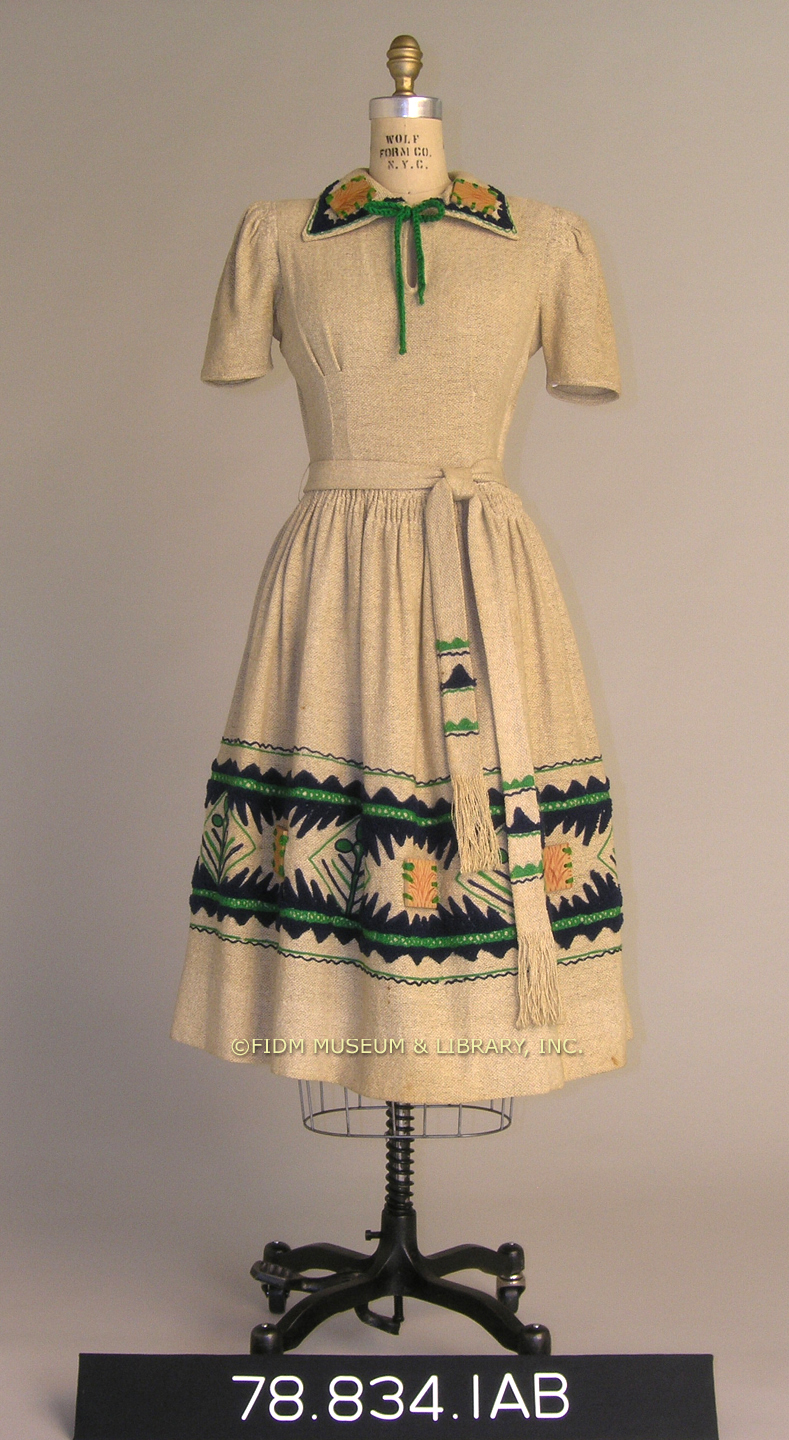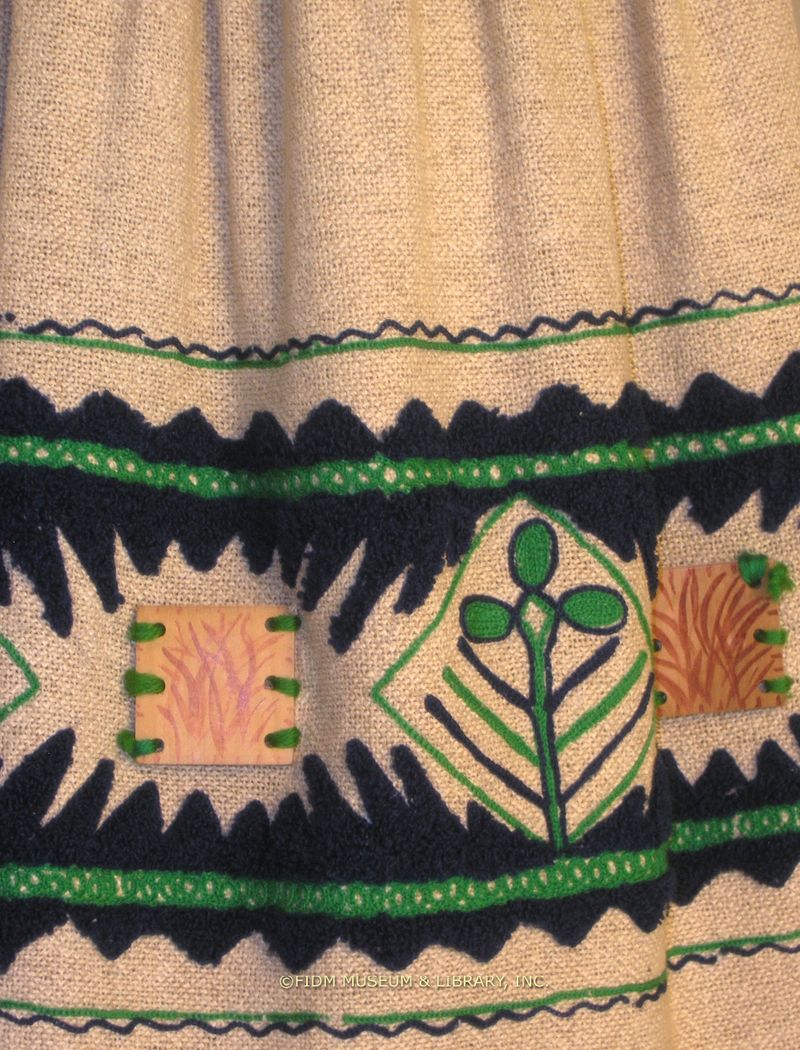Louella Ballerino
Louella Ballerino? Who's that? Though you may not recognize her name, her design sensibility was crucial to the creation and popularization of the California look--casual, functional, colorful clothing designed to complement the relaxed California lifestyle. Her career began in 1929, when economic necessity led Ballerino to begin work as a freelance fashion illustrator in Los Angeles. She also held a full-time position in a custom dress shop and taught evening fashion design courses at a technical college. She worked behind the scenes until 1938, when a manufacturer, who had asked for something "different," rejected her sketch for a peasant-style dress. Ballerino believed that her design had merit, so she hired a manufacturer to make the dress and placed a few in a dress-shop in Hollywood. In her words, "I thought it would be comfortable and fun to wear."1 The women of Los Angeles clearly agreed, as the dress sold out almost immediately. The FIDM Museum is fortunate to have one of Ballerino's career-making dresses in our collection.
 Day dress Louella Ballerino 1938 78.834.1AB Gift of the Louella Ballerino Family
Day dress Louella Ballerino 1938 78.834.1AB Gift of the Louella Ballerino Family
Made of a coarse cotton fabric called hopsacking, the light ground serves as a neutral canvas for the dramatic black and green border print, which is composed of embroidered thread. If you look closely, you'll notice small, painted squares in the center of the border design and on the collar points. Yes, they're real wood, tied in place with green yarn. Ballerino's inspiration for the border print was drawn from the Tongan tribe of Africa. She considered research into design and costume history important to the work of a fashion designer, so she probably encountered a similar motif in a local museum or library. This interest in non-Western cultures was to become a hallmark of her work and of California sportswear in general.
Throughout the 1920s and 1930s, California was promoted as an American paradise. This campaign, along with California's relative proximity to Mexico and Asia, attracted an extremely diverse population. Each group brought with them their own dress traditions, some of which filtered into mainstream fashion. California designers borrowed and altered non-Western garment types for use in casual dresses, swimwear and playsuits. The textiles used in these garments often featured stereotyped decorative elements associated with specific cultures, such as cacti and sombreros intended to represent Mexico. Though some California designers provided barely altered interpretations of non-Western elements, Ballerino typically created an abstracted version of her original inspiration. Annual trips to Mexico, along with library and museum research, fueled Ballerino's work. She often imported handwoven fabrics for use in her self-described "native fashions." The fashion press uniformly labeled Ballerino's creations "peasant influenced" and noted the use of Mexican and South American motifs in her dresses. A 1944 article titled "Mexico Rich in Inspiration for California Designers," called Ballerino "California's leading exponent of the Mexican vogue."2 In later years, Ballerino explored other regions of the world, producing collections inspired by the traditional dress of Italy, India, Holland and numerous other countries. Ballerino's designs always express a deep appreciation for the handmade aspects of traditional dress styles, either in the fabric or in the decorative elements. Ballerino's interest in casual, fun clothing led her to design a variety of garments, all suitable for the "patio lifestyle" of Southern California. Her designs were often multi-functional; a skirt worn over pants could do double-duty as a cape. Ballerino was also popular as a designer of mother/daughter dresses, which often featured full dirndl-style skirts and puff sleeves. Despite her obvious ability to design a range of garments, Ballerino used her first successful dress as a template throughout the 1940s. With a nearly identical silhouette and fabrication, the only variation is in the appearance of the border print. Some later versions of the dress feature decorative elements on the upper chest, rather than the collar points. It is not surprising that Ballerino continued to present variations of her first successful design. It was both the dress that launched her career, and an influential dress that ushered in new trends in surface decoration and wide-spread interest in non-Western dress. Ballerino's talent lay in her ability to reference these elements in a way that seemed new and wearable. She was able to "hit the bright spot"3 that reminded Californians of what was unique about their state culture, creating a look that was both uniquely American and specifically Californian.
1 Williams, Beryl. Fashion is our Business: Careers of Famous American Designers. Philadelphia: J.B. Lippincott. 1945. 156-170.
2 Scallon, Virginia. "Mexico Rich in Inspiration for California Designers." Christian Science Monitor 7 July 1944.:8.
3 Scallon, Virginia. "California Designers Forecast Spring Styles At Showings This Week in Los Angeles." Christian Science Monitor 15 Nov. 1944.:13.
